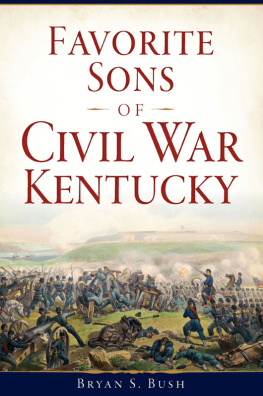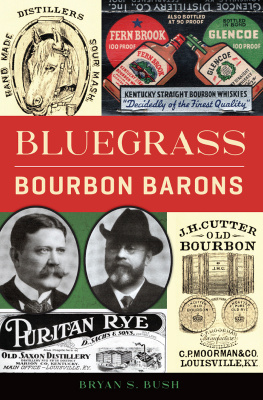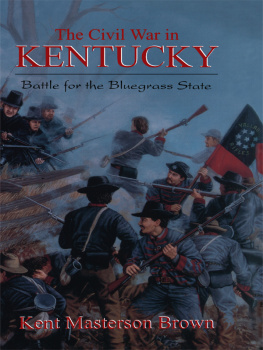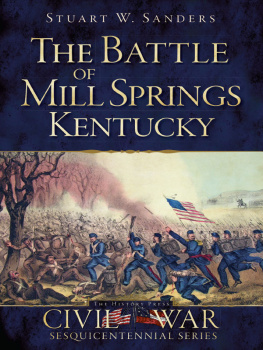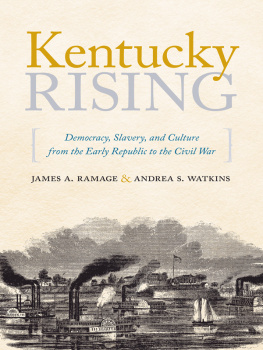

Published by The History Press
Charleston, SC
www.historypress.net
Copyright 2017 by Bryan S. Bush
All rights reserved
Front cover image courtesy of the Library of Congress.
First published 2017
e-book edition 2017
ISBN 978.1.43966.360.8
Library of Congress Control Number: 2017948453
print edition ISBN 978.1.62585.993.8
Notice: The information in this book is true and complete to the best of our knowledge. It is offered without guarantee on the part of the author or The History Press. The author and The History Press disclaim all liability in connection with the use of this book.
All rights reserved. No part of this book may be reproduced or transmitted in any form whatsoever without prior written permission from the publisher except in the case of brief quotations embodied in critical articles and reviews.
CONTENTS
ACKNOWLEDGEMENTS
I would like to thank the Old Bardstown Village Inc. and, in particular, Steve Munson for allowing me to photograph the amazing collection of artifacts at the Civil War Battles of the Western Theater Museum. This site, in Bardstown, Kentucky, features the War of the West. The Civil War Museum was opened in 1988 in the old waterworks building in Bardstown, and between 1988 and 1992, it served more than 250,000 visitors. Between 1992 and 1996, the museum was totally renovated and was incorporated into the Kentucky State Parks system. It officially reopened on June 29, 1996, to the pleasure of Civil War buffs from around the world. The Civil War Museum also has an 1800s pioneer village adjacent to the site featuring several original log cabins in order to depict life during these times. The museum complex also features education on womens role during the Civil War museum and a war memorial museum, which is dedicated to all the wars in which the United States has fought, from the American Revolution to Desert Storm.
I would like to thank the Louisville Free Public Library for allowing me access to its research tools and, in particular, Joseph Hardesty.
I would like to thank Cave Hill Cemetery in Louisville, Kentucky, for its support throughout the years and, in particular, Michael Higgs, coordinator of the Cave Hill Heritage Foundation. Cave Hill Cemetery is Louisvilles premier cemetery. The purpose of the Cave Hill Heritage Foundation is to secure funding for the long-term preservation of this unique cemetery. Specifically, the mission of the Cave Hill Heritage Foundation is threefold:
TO RESTORE THE HISTORICAL MONUMENTS AND BUILDINGS.
Cave Hill Cemetery is known for its exquisite collection of monumental art, many examples of which are more than 150 years old. Additionally, the property includes a variety of historic structures, from the administration office to the board room to the three-and-a-half-mile wall of brick and stone that encircles the perimeter. The resources provided through the foundation will allow cemetery management to be proactive both in addressing specific, long-term conservation projects and in responding to critical situations that require immediate intervention and stabilization.
TO PRESERVE THE ARBORETUM SETTING.
On average, fifty trees are removed each year at Cave Hill Cemetery due to disease, old age or weather damage, and more than one hundred plants are replaced. The Cave Hill Heritage Foundation will help provide resources for the unexpected, as well as help preserve and sustain the beauty of the cemeterys arboretum setting. It will provide for the removal and the replacement of specimen trees and shrubs to ensure that future generations will have access to this amazing green space in the heart of Louisville.
TO PROVIDE COMMUNITY EDUCATION AND AWARENESS.
The history of Cave Hill Cemetery is inextricably tied to the history of Louisville. Through its landscape and monuments, the cemetery tells the story of this beloved city by the river and its remarkable citizenry. The Cave Hill Heritage Foundation will help provide resources to produce educational materials, expand public awareness and develop special events and programs for schoolchildren and the community at large. It will also ensure that the critical task of recording and archiving the history of the cemetery will continue.
I would also like to thank my parents, Carol and Gene Bush, and stepmom, JoAnn Bush, for their support. I would also like to thank my friend Ryan Reynolds for support and inspiration.
INTRODUCTION
In the 1860 election, Kentucky was divided as to who to vote for president. Many Kentucky residents voted for John Bell of Tennessee, who stood for adherence to the Union and maintaining slavery. Other Kentucky residents voted for native son John C. Breckinridge, who was for the Southern Democratic Party, which supported slavery and secession. Some Kentucky residents voted for Stephen Douglas, who was on the Democratic ticket. Very few Kentucky residents voted for native son Abraham Lincoln, who ran on the Republican ticket that stood for the elimination of slavery. Kentucky was a slaveholding state. Kentucky wanted to maintain the institution of slavery and remain loyal to the Union.
When the Civil War began on April 12, 1861, when shots were fired on Fort Sumter, South Carolina, Kentucky had to decide whether to stay in the Union or join the Confederacy. In May, the state voted for neutrality. Although Kentucky may have remained neutral, thousands of Kentuckys brave sons decided that they could not sit the war out and decided to join the Union or the Confederacy. Recruitment agents for the two opposing sides lined the streets of Louisville, Kentucky, asking for volunteers. Union recruits were sent to Camp Joseph Holt in Indiana or Camp Dick Robinson in Garrard County, Kentucky. Those who were recruited for the Confederacy left for New Orleans or Camp Boone in Tennessee. More than 100,000 sons of Kentucky served in the Union army in the Civil War. Between 25,000 and 40,000 Kentucky soldiers fought for the Confederacy.
Kentucky soldiers served in both the Eastern Theater and Western Theater of the Civil War. They fought in battles such as Bull Run, Gettysburg, Antietam and Appomattox. They also fought in the battles for Fort Henry and Fort Donelson, as well as at Shiloh, Baton Rouge, Stones River, Vicksburg, Chickamauga, Atlanta and in South Carolina.
Kentucky soldiers served under Confederate generals such as native Kentuckians John Hunt Morgan, John C. Breckinridge and others such as John Bell Hood, William Hardee, Nathan Bedford Forrest and Thomas Stonewall Jackson. Union Kentucky soldiers fought under men like William T. Sherman and Ulysses S. Grant.
The purpose of this book is to cover Kentucky soldiers who fought for the Union or Confederacy and who made major impacts on Kentuckys history during and after the Civil War. Such examples are Confederate Colonel Philip Lee, who fought in the 1st Kentucky Brigade, also known as the Orphan Brigade. After the Civil War, he became one of the leading prosecuting attorneys in Louisville. For the Union side, Colonels William Boone and J. Rowan Boone served in the 28th Kentucky Union Infantry. Both would become prominent attorneys in Kentucky. William Boone would become related to the Rowan family through marriage and became the attorney for Rebecca Rowan, who was widowed when John Rowan Jr. died through an accident at his home Federal Hill in Bardstown. Rebecca Rowan was burdened with financial debt from her husband, and William Boone helped her until his death. Federal Hill later became known as My Old Kentucky Home. Another example would be David Yandell, who was the chief medical director for Confederate General Albert Sidney Johnston. After the Civil War, he became a prominent doctor and taught medicine at the University of Louisville. After his death, an auditorium was named after him in honor of his medical efforts.
Next page
